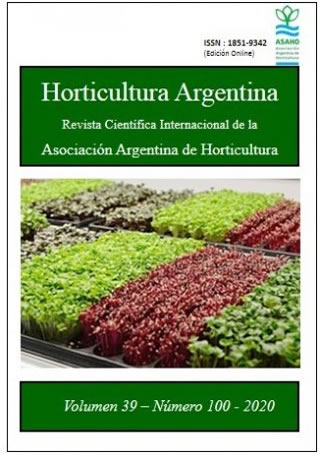Ver ítem
- xmlui.general.dspace_homeCentros Regionales y EEAsCentro Regional Buenos Aires SurEEA Hilario AscasubiArtículos científicosxmlui.ArtifactBrowser.ItemViewer.trail
- Inicio
- Centros Regionales y EEAs
- Centro Regional Buenos Aires Sur
- EEA Hilario Ascasubi
- Artículos científicos
- Ver ítem
Análisis de variables biofísicas en cultivo de cebolla (Allium cepa) con fertilización nitrogenada mediante teledetección
Resumen
La producción de bulbos cebolla (Allium cepa) requiere elevada cantidad de nitrógeno. Acorde a la demanda de la agricultura sustentable, el desarrollo de tecnologías de la información y la comunicación, permite mejorar la eficiencia en la fertilización nitrogenada. En el sur de la provincia de Buenos Aires, Argentina, se cultivan entre 8.000 y 10.000 hectáreas por año entre los distritos de Villarino y Patagones. El objetivo de este trabajo fue analizar
[ver mas...]
La producción de bulbos cebolla (Allium cepa) requiere elevada cantidad de nitrógeno. Acorde a la demanda de la agricultura sustentable, el desarrollo de tecnologías de la información y la comunicación, permite mejorar la eficiencia en la fertilización nitrogenada. En el sur de la provincia de Buenos Aires, Argentina, se cultivan entre 8.000 y 10.000 hectáreas por año entre los distritos de Villarino y Patagones. El objetivo de este trabajo fue analizar la relación de las variables biofísicas: índice de área foliar (IAF), contenido de clorofila en el canopeo (CCC) y factor de cobertura de canopeo (fCOVER) en un cultivo de cebolla de ciclo intermedio con fertilización nitrogenada y su efecto en el rendimiento. Se realizó un ensayo con diferentes dosis de urea granulada y urea granulada con inhibidor de ureasa, donde se evaluaron las características biofísicas a campo y en imágenes del satélite Sentinel-2. Se relacionaron todas las variables y se calculó el rendimiento. En la correlación datos de campo/satélite se obtuvo un R2 de 0,87, 0,96 y 0,79 para índice de área foliar, factor de cobertura y contenido de clorofila respectivamente. La aplicación de nitrógeno en todas sus fuentes y dosis produjo rendimientos significativamente mayores que el testigo. Las variables IAF y CCC tuvieron correlación positiva con el rendimiento en los meses de noviembre y diciembre.
[Cerrar]
The production of onion bulbs (Allium cepa) requires a high amount of nitrogen. According to the demand of sustainable agriculture, the development of information and communication technologies, allows to improve the efficiency of nitrogen fertilization. In the south of the province of Buenos Aires, Argentina, between 8,000 and 10,000 hectares are cultivated per year in the districts of Villarino and Patagones. The aim of this work was to analyze the
[ver mas...]
The production of onion bulbs (Allium cepa) requires a high amount of nitrogen. According to the demand of sustainable agriculture, the development of information and communication technologies, allows to improve the efficiency of nitrogen fertilization. In the south of the province of Buenos Aires, Argentina, between 8,000 and 10,000 hectares are cultivated per year in the districts of Villarino and Patagones. The aim of this work was to analyze the relationship of biophysical variables: leaf area index (LAI), chlorophyll content in canopy (CCC) and canopy cover factor (fCOVER) with nitrogen fertilization of intermediate cycle onion crop and its effects on yield. A trial with different doses of granulated urea and granulated urea with urease inhibitor was carried out, where biophysical characteristics were evaluated in the field and in Sentinel-2 satellite images. All variables were correlated and yield was calculated. In the field/satellite data correlation, an R2 of 0.87, 0.96 and 0.79 for leaf area index, coverage factor and chlorophyll content respectively was obtained, showing a good relationship in the three variables. The application of nitrogen in all its sources and doses produced significantly higher yields than the control. The LAI and CCC variables had a positive correlation with the yield in the months of November and December.
[Cerrar]

Fuente
Horticultura Argentina 39 (100) : 7-24 (Sep. - Dic. 2020)
Fecha
2020-12
Editorial
Asociación Argentina de Horticultura
ISSN
1851-9342
Formato
pdf
Tipo de documento
artículo
Palabras Claves
Derechos de acceso
Abierto
 Excepto donde se diga explicitamente, este item se publica bajo la siguiente descripción: Creative Commons Attribution-NonCommercial-ShareAlike 2.5 Unported (CC BY-NC-SA 2.5)
Excepto donde se diga explicitamente, este item se publica bajo la siguiente descripción: Creative Commons Attribution-NonCommercial-ShareAlike 2.5 Unported (CC BY-NC-SA 2.5)


